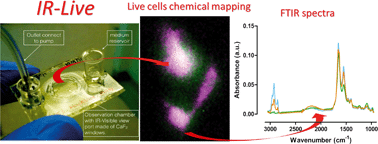IR-Live: fabrication of a low-cost plastic microfluidic device for infrared spectromicroscopy of living cells†
Abstract
Water is a strong mid-infrared absorber, which has hindered the full exploitation of label-free and non-invasive infrared (IR) spectromicroscopy techniques for the study of living biological samples. To overcome this barrier, many researchers have built sophisticated fluidic chambers or microfluidic chips wherein the depth of the liquid medium in the sample compartment is limited to 10 μm or less. Here we report an innovative and simple way to fabricate plastic devices with infrared transparent view-ports enabling infrared spectromicroscopy of living biological samples; therefore the device is named “IR-Live”. Advantages of this approach include lower production costs, a minimal need to access a micro-fabrication facility, and unlimited mass or waste exchange for the living samples surrounding the view-port area. We demonstrate that the low-cost IR-Live in combination with microfluidic perfusion techniques enables long term (>60 h) cell culture, which broadens the capability of IR spectromicroscopy for studying living biological samples. To illustrate this, we first applied the device to study protein and lipid polarity in migrating REF52 fibroblasts by collecting 2-dimensional spectral chemical maps at a micrometer spatial resolution. Then, we demonstrated the suitability of our approach to study dynamic cellular events by collecting a time series of spectral maps of U937 monocytes during the early stage of cell attachment to a bio-compatible surface.



 Please wait while we load your content...
Please wait while we load your content...